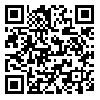Volume 8, Issue 2 (summer 2004)
jwss 2004, 8(2): 91-106 |
Back to browse issues page
Download citation:
BibTeX | RIS | EndNote | Medlars | ProCite | Reference Manager | RefWorks
Send citation to:



BibTeX | RIS | EndNote | Medlars | ProCite | Reference Manager | RefWorks
Send citation to:
N. Zahedifard, S. J. Khajeddin, A. Jalalian. TM Digital Data Application on Land-use Mapping of Bazoft River Basin. jwss 2004; 8 (2) :91-106
URL: http://jstnar.iut.ac.ir/article-1-427-en.html
URL: http://jstnar.iut.ac.ir/article-1-427-en.html
Abstract: (27565 Views)
Satellite data use is finding global applications because they provide repeated cover, broad information, high electromagnetic spectral resolution, and software-hardware compatibilities. This study aims to evaluate of the Landsat TM data capabilities in land-use mapping of Bazoft River basin (Chahar Mahale Bakhtiary Province). Six spectral bands of the Landsate TM were employed to produce land-use map of the Region. The date of image acquisition was May 5th, 1998. Performance of the geometric correction completed with RMSE= 1.008 pixels. Various image enhacement methods (e.g. FCC, filtering and Vegetation Indices) were used to study the different land-covers. Field investigations were carried out using a GPS, 1:50000 scale topographic map and false color composites images. Heterogeneous land-use units were studied in 62 sample sites estimating percentage of vegetation cover. A regression analysis was performed between percentage vegetation covers and vegetation indices values of NDVI, RVI, SAVI, DVI, TSAVI1, NRVI and MSAVI2. Results show that NDVI, SAVI, TSAVI1, NRVI and MSAVI2 have high correlation coefficients. But RVI, DVI and PVI have low correlation coefficients. The resulting values of vegetation cover were density sliced to produce the land-cover map. After supervised classifications and density slicing of Vegetation Indices, classifacation accuracy was assessed and, finally, land-use map of the study area was produced with Hybrid classification method. Supervised classification with maximum likelihood method was the best technique for land-use mapping in the study area the total Kappa index was %87. In general, detection of some land-use classes through single date TM data is not feasible, these include: scattered forest trees with cultivated understory, annual grasses, and fallow lands. Also TM digital data are incapable of distinguishing small and separated rural constructions or soil-covered routes.
| Rights and permissions | |
 | This work is licensed under a Creative Commons Attribution-NonCommercial 4.0 International License. |






